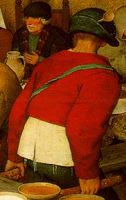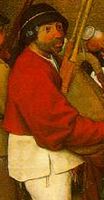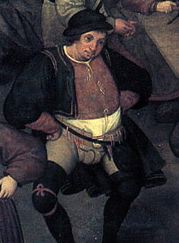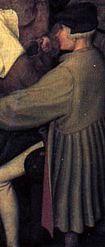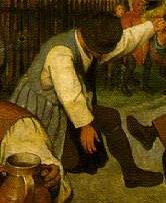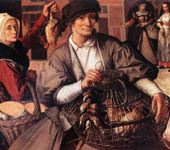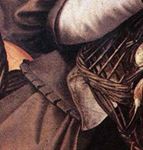| Lorenzo's Progress Log |
This is where I keep track of my sewing projects. Feel free to email me with any comments or questions.
| Sep 22, 2005 |
| Beginnings: Flemish Working Woman's Husband | |
|
I was recently told in no uncertain terms that the next outfit I made for myself I had to able to sit, bend over, and run in without blowing out stitches or complaining about being uncomfortable. To that end, I've decided that, as soon as I finish my wife's new dress, I need to have something to match it. I went back to the same sources that provided the meat of the images for the dress, the paintings of Pieter Brueghel the Elder and Pieter Aertsen. The variety of garments on the men is as great in these paintings as that of the women, if not more so. Millia Davenport comments that these Flemish peasants display a "thrift bordering on poverty" in the maintenance and re-use of their garments. There are hose, breeches, socks, shirts, doublets,vests, jackets, and coats in a wide variety of styles and colors. After all this peering at peasant paintings, I went back to look in the old Book of Costume. Ms. Davenport informs me that, in the early 16th century, "with the advent of pleated bases, separate and often interchangeable skirts to the jacket, the doublet and jacket become less easy to differentiate." She makes specific reference to the waffenrock, a quilted and pleated skirt, of which there is a picture of an extant example. The waffenrock is a military garment, however, and while military dress is often incorporated into civilian clothing, I haven't been able to find any definitive examples of the bases being separate in civilian dress. This does not mean it isn't the case, of course. The question has now moved into the "mock it up and see if it looks right" stage. |
|
| category: /flemish/man | permanent link | |
| Coat Conjecture | |
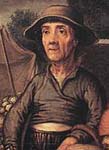  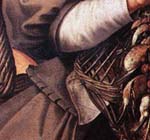 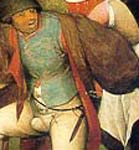 Most of the time, these coats are seen open, and unfortunately most often from the rear. However, sometimes there is evidence of some sort of closure. The first two images show doublets that close on the left side. Those are pretty clear, and show a precedent for this type of closure. Next is the grey coat from the market scene. Near the jacket hem there is a flap of white, apparently the bottom of the coat lapel. Also, the edge of the front opening is only tabbed on the right side, leading me to believe that it overlaps and closes on the left side like the doublets. The image of the dancer also shows a hanging lapel that seems similar. It's not terribly clear, but there appears to be a white loop on the left side of the dancer's coat that could be a button loop. Most of the time, these coats are seen open, and unfortunately most often from the rear. However, sometimes there is evidence of some sort of closure. The first two images show doublets that close on the left side. Those are pretty clear, and show a precedent for this type of closure. Next is the grey coat from the market scene. Near the jacket hem there is a flap of white, apparently the bottom of the coat lapel. Also, the edge of the front opening is only tabbed on the right side, leading me to believe that it overlaps and closes on the left side like the doublets. The image of the dancer also shows a hanging lapel that seems similar. It's not terribly clear, but there appears to be a white loop on the left side of the dancer's coat that could be a button loop.I've thrown together a rough paper doll sketch showing a possible outfit with doublet, jacket, and bases. |
|
| category: /flemish/man | permanent link | |
| More Pictures | |
| I've got a few more pictures. First, a couple slighty better lit shots of the coat. Also I took some pictures of the hose pointed to the doublet requested by Klaus, who helped me work out how to get the hose right. | |
| category: /flemish/man | permanent link | |
| Finished | |
| I got the eyelets done last night. I was worried that once I had everything tied up that I wouldn't be very mobile; after all, the guys in the paintings have their points untied for a reason. I was pleasantly surprised to find that I was just as comfortable with the points tied as untied. There's nothing left to do now except tweak the shirt a little bit, so I'm going to move this to the completed pile. | |
| category: /flemish/man | permanent link | |
| Finished (More Or Less) | |
 The material I ended up choosing for the coat lining is a shiny remnant with a pattern of tiny diamonds. It's probably entirely inappropriate, but the color was just what I wanted and I had barely enough. I had to piece together bits to fill out the back and still leave enough to line the skirt. The length of the skirt was determined by how much I had left over of the lining after patterning the body. As planned, I put in a pair of lacing holes on the left side that point to a ring inside the right side. The flap closes with a black thread covered button. The sleeves are wide and unlined, gathered to a small cuff. The material I ended up choosing for the coat lining is a shiny remnant with a pattern of tiny diamonds. It's probably entirely inappropriate, but the color was just what I wanted and I had barely enough. I had to piece together bits to fill out the back and still leave enough to line the skirt. The length of the skirt was determined by how much I had left over of the lining after patterning the body. As planned, I put in a pair of lacing holes on the left side that point to a ring inside the right side. The flap closes with a black thread covered button. The sleeves are wide and unlined, gathered to a small cuff.I had to manipulate these pictures quite a bit since my lighting skills still leave much to be desired. I will happily entertain requests for any detail photos. I still have to finish the rest of the lacing holes at the waist, but other than that I can call this project finished. |
|
| category: /flemish/man | permanent link | |
| Some Pictures | |
  As requested, here are some detail shots of the coat closure. You can also see the very un-peasant-like lining material better here. I've got a piece of hemp twine for a point right now; I'll probably replace it with something a touch nicer. As requested, here are some detail shots of the coat closure. You can also see the very un-peasant-like lining material better here. I've got a piece of hemp twine for a point right now; I'll probably replace it with something a touch nicer.
|
|
| category: /flemish/man | permanent link | |
| Getting Closer | |
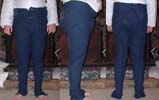 I'm very happy with the fit of these hose now. They're not too baggy except a little in the seat, but that's just something I'll have to live with if I want to bend over. You can see the gusset I had to put in the rear. It's ugly, but not too bad for a prototype. I have a full range of motion without binding or straining. I was worried that they wouldn't stay up very well during my earlier fittings. I decided to add a five inch wide strip of fulled wool as a lining for the waistband. It not only eliminates the problem of excessive stretchiness, but also gives a little more "grip" to keep the hose from falling down. It will also give more strength to the lacing holes. I still have quite a bit of work to do. I'm going to flat fell all the seams for extra strength and durability, finish the top opening, add lacing holes, build the codpiece, and add feet. The hardest part I think is behind me now, though. I'm very happy with the fit of these hose now. They're not too baggy except a little in the seat, but that's just something I'll have to live with if I want to bend over. You can see the gusset I had to put in the rear. It's ugly, but not too bad for a prototype. I have a full range of motion without binding or straining. I was worried that they wouldn't stay up very well during my earlier fittings. I decided to add a five inch wide strip of fulled wool as a lining for the waistband. It not only eliminates the problem of excessive stretchiness, but also gives a little more "grip" to keep the hose from falling down. It will also give more strength to the lacing holes. I still have quite a bit of work to do. I'm going to flat fell all the seams for extra strength and durability, finish the top opening, add lacing holes, build the codpiece, and add feet. The hardest part I think is behind me now, though.
|
|
| category: /flemish/man | permanent link | |
| Doublet And Hose | |
 The doublet and hose are wearable at this point, though they still lack lacing holes at the waist. It's all very comfortable and leaves me able to do whatever I need to. Next on the list is the coat, which I hope to at least get started today. I'm still working on getting my camera set up in the right spot to get good pictures, so this one is a little rough. The doublet and hose are wearable at this point, though they still lack lacing holes at the waist. It's all very comfortable and leaves me able to do whatever I need to. Next on the list is the coat, which I hope to at least get started today. I'm still working on getting my camera set up in the right spot to get good pictures, so this one is a little rough.
|
|
| category: /flemish/man | permanent link | |
| Recycled Hose | |
| In the spirit of peasant frugality, I've decided to recycle the first pair of hose I made from the green stretch cotton. I cut off the feet, which had long since worn out anyway. The waist needs to be turned down to even it out, and since the waist will need to be higher than before I need to add gussets at the inseam. I'll still need to make knee high stockings, but that'll be much less work. I'm also going to recycle a shirt I made for a Turkish outfit that didn't fit quite right. | |
| category: /flemish/man | permanent link | |
| Hosed | |
| I tried rebuilding the old hose, but it was really a lot more work than just starting from scratch. I remember now why I made all my Italian stuff with separate hose. I've started a fresh new pattern in blue cotton. I have to remind myself again: make sure it fits first, then start finishing it. | |
| category: /flemish/man | permanent link | |

